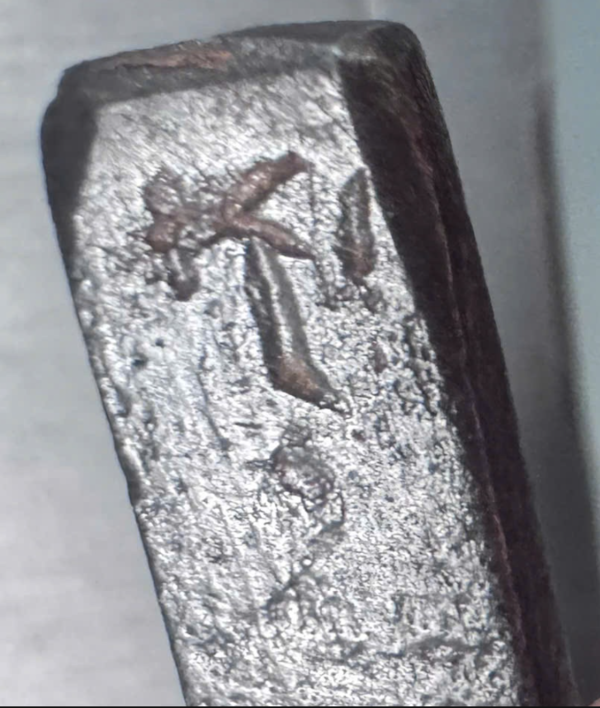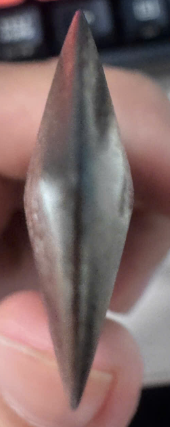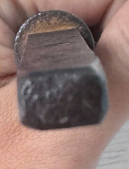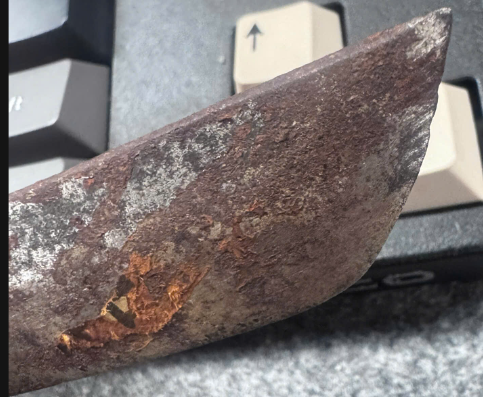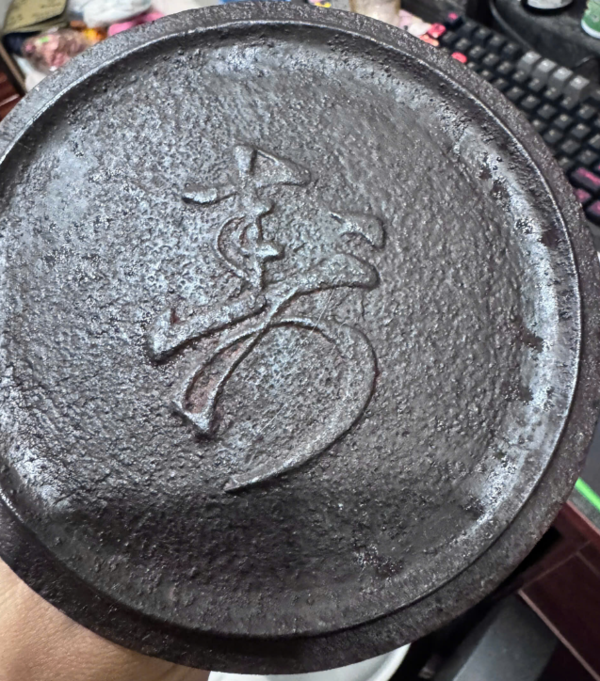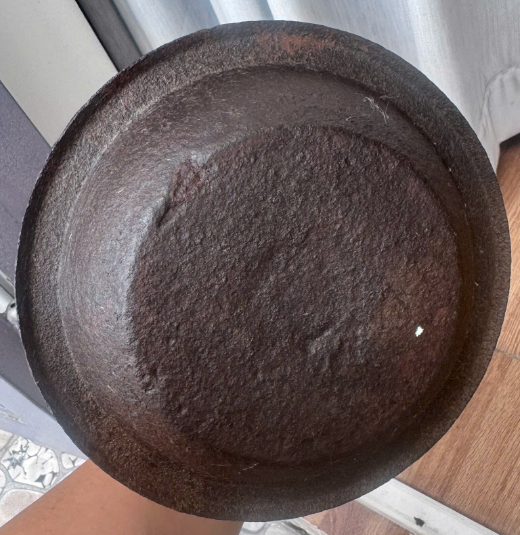-
Posts
16 -
Joined
-
Last visited
Profile Information
-
Gender
Male
-
Location:
Việt Nam
Profile Fields
-
Name
Jack
Recent Profile Visitors
The recent visitors block is disabled and is not being shown to other users.
JackDo's Achievements
-
Hello everyone, I recently found another yari with a very interesting shape — it looks like a sankaku (triangular) piercing type, almost like an awl designed to punch through armor. The blade length is about 15 cm, the nakago about 23 cm, and the maximum width only 1.7 cm, which makes it quite slim and compact compared to most standard yari. There are some impact marks and a small chip on one edge, as well as pressure dents along the ridge, suggesting it may have struck. The tang bears a mei, although it has been softened a bit by time. It also seems that the previous owner or seller cleaned off some rust on the blade, leaving a partially bright surface while the nakago retains its old patina. I would really appreciate your thoughts on its possible age, school, and origin. Thank you for your time and expertise! Best regards, Jack!
-
Thank you very much, Jean and Piers — that’s a fascinating possibility I hadn’t thought of. Fire damage would certainly explain the deep pitting and the loss of any visible hamon. I’m glad to know the proportions still look right, at least structurally. I’ll make sure to photograph and present blades tip-up from now on — thank you for pointing that out, Jean. I also wanted to ask about the intended type or purpose of this yari. It feels quite short, heavy, and now very dull — would that originally have been a combat yari, or could it have been one of the shorter police or guard types used in later Edo? Or perhaps it simply lost its sharpness due to the fire and corrosion over time?
-
Thank you very much, Brian and Piers — that’s a very helpful and thoughtful observation. You’re right, the kerakubi area does have some pitting, and I also noticed the uneven surface under certain lighting. It might have been roughly cleaned at some point before I found it, but I can’t be sure. I really appreciate your cautious approach — I’m here to learn and not to prove anything, so any further comments or comparison examples would be very welcome.
-
Hi everyone, I recently acquired an yari blade and would really appreciate some help identifying it. The blade has a signature (mei) ? Here are some details : Blade length: 10.5 cm Maximum width: 2.5 cm Tang (nakago) length: 7.5 cm The tang shows two mekugi-ana, but one appears to be only a marking hole (not fully drilled through). The blade is now completely dull, with no remaining sharp edge. The steel shows a dark, aged patina, but no visible hamon under normal light. The overall form feels similar to a late Edo-period su-yari, but I’m not certain. I’ve attached several photos showing the mei, tang, and cross-section. I wonder if anyone might ? Or if it could be a later piece or reproduction made in traditional style. Thank you very much for your time and expertise. -Jack
-
I'm still quite inexperienced, but from the posts and examples I've read so far, it seems that most of the fake or non-Japanese blades are usually made of Damascus steel, right?
-
Thank you, Jean. You’re absolutely right — that’s what fascinates me the most. Every time I hold a blade, I can’t help but wonder about its past — who made it, who carried it, what kind of life it had before ending up in my hands. That mystery is what makes this hobby so special to me. I really appreciate your kind insight!
-
Thank you very much, Jean. I really appreciate your time and the knowledge you shared. I’m very excited to learn from everyone here and to understand more about the piece I have. Thank you again for helping me gain new insight — and I’m sorry if some of my questions sounded too naïve or curious. I’m still learning, and I truly enjoy the process.
-
Thank you very much for the clarification! That makes a lot of sense — I did notice the kissaki looked unusually blunt and the overall sugata didn’t quite fit typical tantō proportions. I really appreciate everyone’s insights. If it’s not too much to ask, I’d be very interested to hear any thoughts about the possible period or school this blade might have originated from, based on the remaining nakago shape or yasurime. I completely understand that a reshaped fragment like this makes it difficult to determine precisely — I’m just curious from a learning perspective.
-
Thank you very much, Zoglet, for your insights — I really appreciate your time and expertise! I’m not disappointed at all — I mainly collect these old blades out of curiosity and fascination, rather than for value. Here are a few more photos of the full blade (both sides and the spine) for better reference. The nagasa is about 23 cm and the nakago is 8.5 cm. The blade edge and tip are not sharp — it’s hard to tell if they were ever sharpened or intentionally left blunt. The blade has been kept wrapped in newspaper for many years, and some of that paper seems to have bonded into the surface rust. I’d really appreciate any advice on how to deal with this properly without causing further damage. Thanks again for your time and kind help! Best regards Jack
-
Hello everyone, I recently acquired an old tanto blade from a flea market in Japan, and I would be very grateful if the experts here could help me better understand its origin and purpose. Here are some measurements and details: Nagasa (blade length): 23 cm Nakago (tang length): 8.5 cm Mekugi-ana: two holes, the first located about 3.5 cm from the machi, and the second about 1 cm apart from the first. The tang shows natural dark brown patina, not artificial rust. The blade edge is not sharp, and the kissaki (tip) appears to have been either intentionally ground flat or perhaps never sharpened. The overall geometry still follows the traditional tanto shape with a visible shinogi ridge. According to the seller, the blade had been stored wrapped in newspaper for a very long time, and some paper fibers seem to have fused into the rust on the surface. I would really appreciate your opinions on a few questions: Does this appear to be a genuine old nihonto blade , or could it be an unfinished ? How should I safely clean or stabilize the surface, especially the rust mixed with old paper residue, without damaging the patina on the nakago? Thank you very much for your time, patience, and for sharing your knowledge with newcomers like me. I really appreciate any guidance and feedback you can offer. Any comments or suggestions will be greatly appreciated. Best regards,
-
Hello everyone, I’m looking for help identifying this old Nanbu Tetsubin (Japanese cast iron kettle) that I recently obtained. Here are the main details I’ve observed: Material: Pure cast iron (non-enameled interior). Casting style: Sand-cast, entirely handmade. Handle: – Removable handle (可動弦 / kadōzuru) type. – The handle is forged iron, attached through small pivoting rings on each shoulder. – Surface shows hammer marks, suggesting hand-forging rather than casting. Surface pattern: – Full-body kiku-mon (chrysanthemum pattern), hand-stamped and overlapping. – Subtle irregularities suggest pre-industrial stamping methods. Seal / Signature: – Vertical inscription on the side, appears to read 「南部盛榮堂造」 (Nanbu Seieidō zō) — though slightly worn. – Relief casting, not engraved post-production. Base: – Flat base with natural casting texture. – No vent holes or polishing marks, consistent with late 19th–early 20th century craftsmanship. Estimated period: Late Meiji to early Taishō (circa 1890–1920). Origin: Possibly from Morioka, Iwate Prefecture. I’d appreciate any insights about: Whether this seal truly corresponds to Seieidō or a related workshop. The approximate period and type of casting mold. Any advice for conservation (I’m currently seasoning it with strong tea infusion to stabilize patina). Photos included: side seal, lid knob, handle joint, and base. Thank you very much for your time and expertise.
-
Thank you very much everyone for your helpful comments and explanations. I would just like to add that this tanto was not purchased from a sword dealer, but rather found among household items being sold when Japanese families were clearing out old belongings. That is why I was curious about its history and possible background. It feels wonderful to learn so much from this community. I am truly impressed by the depth of knowledge here — how much can be understood and explained from just a piece of old steel. This field is truly fascinating and very inspiring to me.
-
JackDo changed their profile photo
-
Thanks everyone for the helpful comments. If this blade was indeed once part of a longer sword that broke and was reshaped, I am curious to know more about the historical background. Why did Japanese sword owners or smiths choose to reuse a broken blade in this way instead of discarding it? Was this a common practice in history, and what were the main reasons behind it ? I’d be very interested to learn more about this aspect of Japanese sword culture.
-
Hello everyone, Thank you very much for your valuable insights. Regarding the tsuka, I also appreciate the information about Kabazaiku and its history. That was very interesting to learn. I will try to take and share clearer photos of the nakago and kissaki area, in case there are still details (such as a possible faint boshi or file marks) that could help in further identification. Thanks again for your time and advice!













